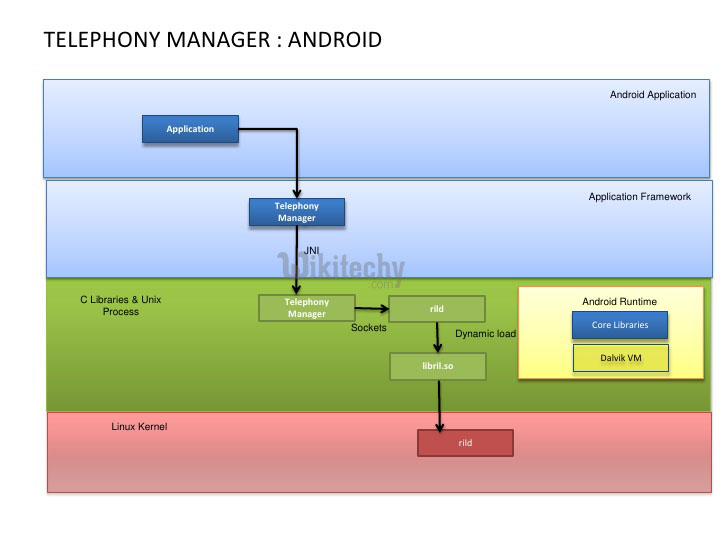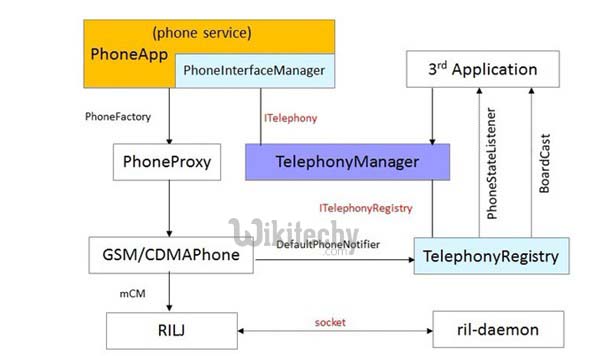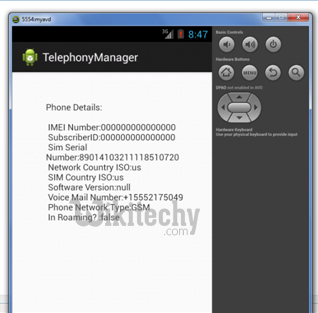Android tutorial - Android TelephonyManager - android app development - android studio - android development tutorial

Learn android - android tutorial - Android telephonymanager - android examples - android programs
Definition of TelephonyManager:

- Provides access to information about the telephony services on the device.
- Applications can use the methods in this class to determine telephony services and states, as well as to access some types of subscriber information.
- Applications can also register a listener to receive notification of telephony state changes.
- The android.telephony.TelephonyManager class provides information about the telephony services such as subscriber id, sim serial number, phone network type etc.
- Moreover, you can determine the phone state etc.

Android TelephonyManager Example
- Let's see the simple example of TelephonyManager that prints information of the telephony services.
activity_main.xml
- Drag one textview from the pallete, now the xml file will look like this.
File: activity_main.xml
<RelativeLayout xmlns:androclass="http://schemas.android.com/apk/res/android"
xmlns:tools="http://schemas.android.com/tools"
android:layout_width="match_parent"
android:layout_height="match_parent"
android:paddingBottom="@dimen/activity_vertical_margin"
android:paddingLeft="@dimen/activity_horizontal_margin"
android:paddingRight="@dimen/activity_horizontal_margin"
android:paddingTop="@dimen/activity_vertical_margin"
tools:context=".MainActivity" >
<TextView
android:id="@+id/textView1"
android:layout_width="wrap_content"
android:layout_height="wrap_content"
android:layout_alignParentLeft="true"
android:layout_alignParentTop="true"
android:layout_marginLeft="38dp"
android:layout_marginTop="30dp"
android:text="Phone Details:" />
</RelativeLayout>
click below button to copy the code from android tutorial team
Activity class
- Now, write the code to display the information about the telephony services.
File: MainActivity.java
package com.wikitechy.telephonymanager;
import android.os.Bundle;
import android.app.Activity;
import android.content.Context;
import android.telephony.TelephonyManager;
import android.view.Menu;
import android.widget.TextView;
public class MainActivity extends Activity {
TextView textView1;
@Override
protected void onCreate(Bundle savedInstanceState) {
super.onCreate(savedInstanceState);
setContentView(R.layout.activity_main);
textView1=(TextView)findViewById(R.id.textView1);
//Get the instance of TelephonyManager
TelephonyManager tm=(TelephonyManager)getSystemService(Context.TELEPHONY_SERVICE);
//Calling the methods of TelephonyManager the returns the information
String IMEINumber=tm.getDeviceId();
String subscriberID=tm.getDeviceId();
String SIMSerialNumber=tm.getSimSerialNumber();
String networkCountryISO=tm.getNetworkCountryIso();
String SIMCountryISO=tm.getSimCountryIso();
String softwareVersion=tm.getDeviceSoftwareVersion();
String voiceMailNumber=tm.getVoiceMailNumber();
//Get the phone type
String strphoneType="";
int phoneType=tm.getPhoneType();
switch (phoneType)
{
case (TelephonyManager.PHONE_TYPE_CDMA):
strphoneType="CDMA";
break;
case (TelephonyManager.PHONE_TYPE_GSM):
strphoneType="GSM";
break;
case (TelephonyManager.PHONE_TYPE_NONE):
strphoneType="NONE";
break;
}
//getting information if phone is in roaming
boolean isRoaming=tm.isNetworkRoaming();
String info="Phone Details:\n";
info+="\n IMEI Number:"+IMEINumber;
info+="\n SubscriberID:"+subscriberID;
info+="\n Sim Serial Number:"+SIMSerialNumber;
info+="\n Network Country ISO:"+networkCountryISO;
info+="\n SIM Country ISO:"+SIMCountryISO;
info+="\n Software Version:"+softwareVersion;
info+="\n Voice Mail Number:"+voiceMailNumber;
info+="\n Phone Network Type:"+strphoneType;
info+="\n In Roaming? :"+isRoaming;
textView1.setText(info);//displaying the information in the textView
}
}
click below button to copy the code from android tutorial team
AndroidManifest.xml
- You need to provide READ_PHONE_STATE permission in the AndroidManifest.xml file
File: AndroidManifest.xml
<?xml version="1.0" encoding="utf-8"?>
<manifest xmlns:androclass="http://schemas.android.com/apk/res/android"
package="com.wikitechy.telephonymanager"
android:versionCode="1"
android:versionName="1.0" >
<uses-sdk
android:minSdkVersion="8"
android:targetSdkVersion="17" />
<uses-permission android:name="android.permission.READ_PHONE_STATE"/>
<application
android:allowBackup="true"
android:icon="@drawable/ic_launcher"
android:label="@string/app_name"
android:theme="@style/AppTheme" >
<activity
android:name="com.wikitechy.telephonymanager.MainActivity"
android:label="@string/app_name" >
<intent-filter>
<action android:name="android.intent.action.MAIN" />
<category android:name="android.intent.category.LAUNCHER" />
</intent-filter>
</activity>
</application>
</manifest>
click below button to copy the code from android tutorial team
Output:

